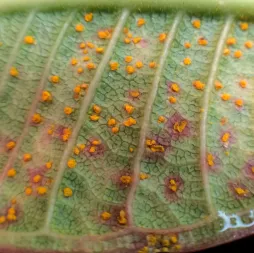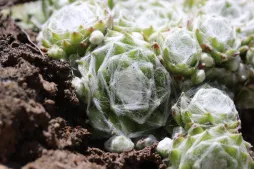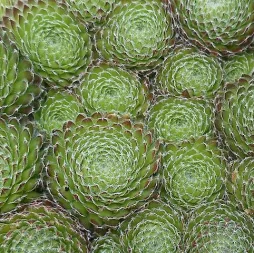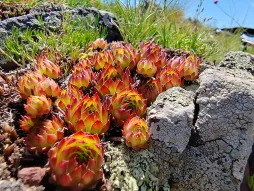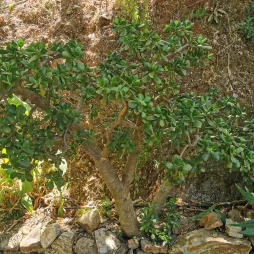Sempervivum montanum, mountain houseleek
You can be small, but stand up to anything. Sempervivum montanum, also known as mountain houseleek, grows at high altitudes on the rock faces of the Alps and Pyrenees. This member of the Crassulaceae family tolerates snow and temperatures down to -25°.
How to recognize mountain houseleek, Sempervivum montanum?
A small succulent with a creeping habit, Sempervivum montanum doesn't exceed 20 centimetres in height when in flower. At other times, it measures five centimetres in all directions.
Sempervivum montanum has no stems. Leaves grow in rosettes four to six centimetres in diameter. Obovate, they are bright green with purple tips. Sticky, glandular hairs cover both sides of the leaf blades. As with spider's web houseleek and roof Jewel, this fine down helps the plant retain water.
Sempervivum montanum flowers in summer. Corymbs of pink flowers bloom at the top of a fifteen-centimetre flowering spike. Once flowering is over, the plant dies. But it leaves behind numerous shoots, ready to take over.
Not all experts agree on the toxicity of Sempervivum. For some, mountain houseleek is harmless. For others, it contains substances that are harmful if ingested, especially by cats.
Our maintenance tips
Mountain Meadowlark are easy-living outdoor plants. All they need is a sunny spot and a well-draining substrate. They can flourish on a roof, in the crack of a low wall or in a rockery. You can also grow them in pots. There's just one rule: don't mix them with other species, which might take over.
Watering
Mountain Meadowlark come from arid regions. They can withstand drought, but that's no reason to neglect their water supply! If your succulent's leaves point downwards, it's thirsty.
Make sure the substrate is dry before watering. That way, you'll avoid overwatering. Once you've got your watering can, be generous. The plant prefers to be watered less frequently but abundantly than to receive frequent small quantities of water.
Half an hour after watering, remove any stagnant water from the dish. It will rot the roots.
Half an hour after watering, remove any stagnant water from the dish. It will rot the roots.
Spray
Mountain Meadowlark grow in arid regions and do not like humidity. No need to spray them.
Repotting
Every spring, repot your Sempervivum montanum to give it more space.
Obtain a pierced terracotta pot. Line the bottom with a layer of clay balls or gravel. This way, in the event of over-watering, your plant won't get its feet wet.
Add a mixture of garden soil (50%) and sand or pozzolan (50%). Plant your Mountain houseleek in the center. Tamp and water to remove air bubbles.
Prune
Remove dried leaf rosettes after flowering.
Plantation
When the risk of frost has passed, it's time to plant.
Choose a sunny, well-drained spot, such as the top of a slope. Loosen your soil by scratching it. If your soil is compact, add sand, crushed pozzolana or gravel to lighten it.
Dig a hole the size of the root ball and plant your Mountain houseleek. Space the different plants at least 20 cm apart to give the shoots room to develop. Don't plant other, larger varieties nearby. They may overshadow and take over the whole space.
Tamp and water to help the plant take root.
Cutting
Cutting is carried out during the strong growth phase, generally in spring and early summer.
Using your hands or a clean, sharp tool, separate one of the shoots that has formed at the base of the plant. Choose a young shoot with roots.
Obtain a perforated pot. Add a layer of clay balls or gravel to the bottom for drainage.
Mix equal parts garden soil and sand or crushed pozzolan. Plant mountain Jewel in the center. Tamp gently and water generously to encourage rooting.
Disease / Threat
Information
| Family | Crassulaceae - Crassulaceae |
| Type | Joubarbe - Sempervivum |
| Species | Mountain houseleek - Sempervivum montanum |
| Lifecycle | Perennial |
| Foliage | Evergreen |
| Exposures | |
| Substrats | |
| Planting methods |
Open ground In pots Planter |
| Categories | |
| Tags |
Beginner Flowery Rustic Toxic |
| Origin |
Southern Europe |
| Hardiness (USDA) | 6a |
| Leaf color |
|
| Flower color |
|
Discover plants from the same family












